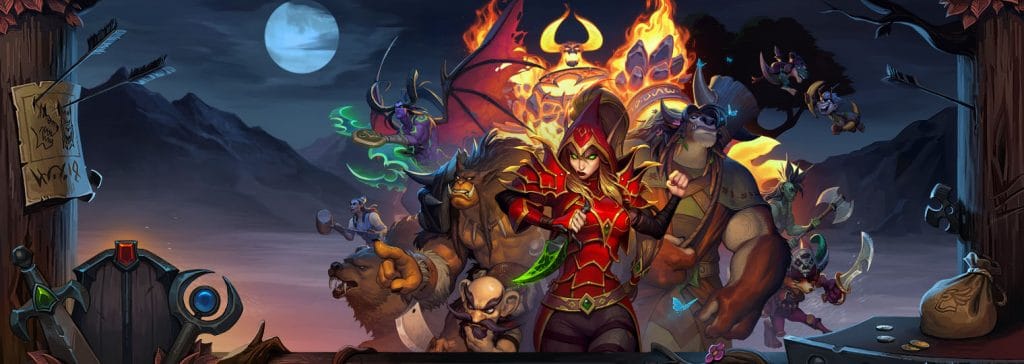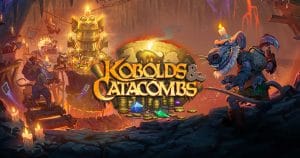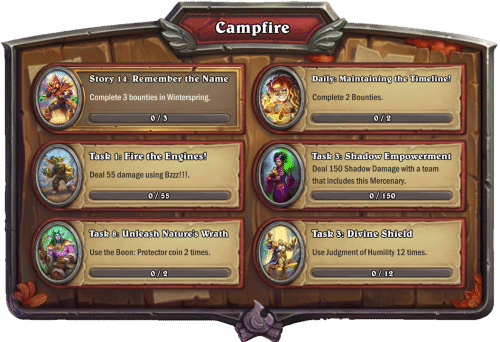- November 15, 2021
- By neon31
- In Articles
- No Comment
- 0
In Defense of Mercenaries: Selling PVE in a PVP Engine

After months of delays and still packing a few bugs, Mercenaries finally arrived to an eager player base ready to explore its promises of expansive PVE content and cerebral PVP endgame. A month into game play, the much-maligned mode is subject to jaded dismissals as “just another gacha game” from disappointed paying customers; laments of an endless grind from casual gamers; and ironically, also that it is a pay-to-win mode. While the game mode is far from perfect, it is very fun, and I urge players to keep in perspective the goals of the mode before damning it with harsh judgment.
Prefer to listen instead of reading? Check out the Video about this topic!
 The key context for mercenaries is the PVE aspect of Hearthstone and its paramour, World of Warcraft. At launch, Hearthstone provided PVE content free to all players for years. It was not until the Kobolds and Catacombs Dungeon Run that the PVE content really became dynamic and challenging, but it was steady and fun nonetheless.With the advent of Dungeon Run and the PVE content thereafter, players saw two years of completely free PVE content with countless hours of unique replay value, culminating in Tombs of Terror – which was the last “Dungeon Run” style offering. These modes gave players a close-up look at the story and inspiration behind the cards, along years of gameplay, at no cost whatsoever, without the burden of relying on a collection. For those who played World of Warcraft, which was also story-focused and PVE-driven, these were welcome, immersive offerings.
The key context for mercenaries is the PVE aspect of Hearthstone and its paramour, World of Warcraft. At launch, Hearthstone provided PVE content free to all players for years. It was not until the Kobolds and Catacombs Dungeon Run that the PVE content really became dynamic and challenging, but it was steady and fun nonetheless.With the advent of Dungeon Run and the PVE content thereafter, players saw two years of completely free PVE content with countless hours of unique replay value, culminating in Tombs of Terror – which was the last “Dungeon Run” style offering. These modes gave players a close-up look at the story and inspiration behind the cards, along years of gameplay, at no cost whatsoever, without the burden of relying on a collection. For those who played World of Warcraft, which was also story-focused and PVE-driven, these were welcome, immersive offerings.
With the advent of Dungeon Run and the PVE content thereafter, players saw two years of completely free PVE content with countless hours of unique replay value, culminating in Tombs of Terror – which was the last “Dungeon Run” style offering. These modes gave players a close-up look at the story and inspiration behind the cards, along years of gameplay, at no cost whatsoever, without the burden of relying on a collection. For those who played World of Warcraft, which was also story-focused and PVE-driven, these were welcome, immersive offerings.
 Most observers have noted that this was not sustainable from a game development perspective. Without any way to pay for the expenditure of vast PVE content, it eventually dried up. However, it coincided with the announcement of Mercenaries: a new mode that would be PVE-centric with a PVP option, which would be free to play but also have a buy-in option.
Most observers have noted that this was not sustainable from a game development perspective. Without any way to pay for the expenditure of vast PVE content, it eventually dried up. However, it coincided with the announcement of Mercenaries: a new mode that would be PVE-centric with a PVP option, which would be free to play but also have a buy-in option.
This is the core context for Mercenaries that detractors forget: the goal of the game was to provide months of PVE gameplay. It seems there is a lot of backlash from players who have spent upwards of 10 hours a day grinding characters, who complain that there is not enough content. For perspective, the game provides 4 tasks a day, and with 56 mercs having 18 tasks each, it would take 8 months to complete the PVE content at the suggested pace. For players who do that in 8 days and complain about the grind, this is a self-made problem.
On the other hand, many casual players yearn to use their preferred mercs, only to stare down the arduous grind required to do so. This is actually a feature – a good feature, I argue – rather than a bug. Though the game is designed to take a long time to make it through the full content, any player can focus their time and effort to acquire and max any single merc with relatively fast speed through targeted bounties, and then through tasks. This mirrors the World of Warcraft experience as well, where players can get good gear a number of ways, but can get a specific piece of gear by running the same dungeon many times until it drops. It takes time, it takes intention, but it does not take money. By adding this capability, players can choose the experience they want, aim for it, and achieve it relatively fast. Shouldn’t we say this is a good thing?
 The next charge leveled against the game is, well… the charges. Many who pre-ordered large amounts of packs feel swindled, for three reasons. Firstly, they have a glut of useless coins for maxed characters. Secondly, there is no pity timer for legendary mercs from packs. Thirdly, the bizarre duplicate protection system is confusing, and when a player is missing mercs and opens portraits or coins and no new mercs, it is frustrating and feels like there is no protection at all. Honestly, these are all very fair criticisms, and result in significant diminishing returns on paying for packs. From a design perspective, this implies that the intent was for a free-to-play system with the option to pay for some extra speed. Accusations that this is a pay-to-win system are assuming that a person will be spending hundreds of dollars on packs and offers. It seems that some people have done this, and run up against the diminishing returns built into the system. This was a severe unforced error for the business, because it exclusively alienates their best customers. As for the free-to-play crowd, they should rejoice, because it means that those who play will max out their collection slightly faster (or substantially faster, depending on the amount spent), but that advantage is blunted by the built-in diminishing returns. Moreover, only six mercs are usable at a time, so a highly-skilled free player with a good team can beat a mediocre whale with 56 maxed mercs. From a game-play perspective, we should again be grateful for this level playing field. But for those who have opened their wallets, their ire is understandable.
The next charge leveled against the game is, well… the charges. Many who pre-ordered large amounts of packs feel swindled, for three reasons. Firstly, they have a glut of useless coins for maxed characters. Secondly, there is no pity timer for legendary mercs from packs. Thirdly, the bizarre duplicate protection system is confusing, and when a player is missing mercs and opens portraits or coins and no new mercs, it is frustrating and feels like there is no protection at all. Honestly, these are all very fair criticisms, and result in significant diminishing returns on paying for packs. From a design perspective, this implies that the intent was for a free-to-play system with the option to pay for some extra speed. Accusations that this is a pay-to-win system are assuming that a person will be spending hundreds of dollars on packs and offers. It seems that some people have done this, and run up against the diminishing returns built into the system. This was a severe unforced error for the business, because it exclusively alienates their best customers. As for the free-to-play crowd, they should rejoice, because it means that those who play will max out their collection slightly faster (or substantially faster, depending on the amount spent), but that advantage is blunted by the built-in diminishing returns. Moreover, only six mercs are usable at a time, so a highly-skilled free player with a good team can beat a mediocre whale with 56 maxed mercs. From a game-play perspective, we should again be grateful for this level playing field. But for those who have opened their wallets, their ire is understandable.
 As a World of Warcraft alum, I am no stranger to grinding level and gear to play the best parts of the game. But a better model for comparison for Mercenaries, with obvious parallels, is Pokemon. Pokemon also has 6-character teams, each with types and counter-types, and a herculean grind built into the game, and optional PVP after the grind. Players have to hope to catch a preferred Pokemon in random zones (see: bounties), some of which are not accessible until several hours of gameplay (see: Blackrock Mountain). They then have to level them up to max level through many hours of grinding, and if they decide to play against other players, may find their team to be suboptimal and have to repeat the process with new, better pokemon. In fact, some of the best pokemon are legendary and difficult to find, like legendary birds (see: Diablo). Rather than met with vitriol, Pokemon was met with acclaim, was game of the year according to many sources, often hailed as the best game ever made, and spawned dozens of follow-on versions, each purchasable from the store at full retail price. Mercenaries mirrored the Pokemon formula, but it is completely free, and allowed players to speed up the grind with tasks, or opt out of some of the grind with money. For some reason, this indulgence was lambasted. When compared to similar games, is that criticism really fair?
As a World of Warcraft alum, I am no stranger to grinding level and gear to play the best parts of the game. But a better model for comparison for Mercenaries, with obvious parallels, is Pokemon. Pokemon also has 6-character teams, each with types and counter-types, and a herculean grind built into the game, and optional PVP after the grind. Players have to hope to catch a preferred Pokemon in random zones (see: bounties), some of which are not accessible until several hours of gameplay (see: Blackrock Mountain). They then have to level them up to max level through many hours of grinding, and if they decide to play against other players, may find their team to be suboptimal and have to repeat the process with new, better pokemon. In fact, some of the best pokemon are legendary and difficult to find, like legendary birds (see: Diablo). Rather than met with vitriol, Pokemon was met with acclaim, was game of the year according to many sources, often hailed as the best game ever made, and spawned dozens of follow-on versions, each purchasable from the store at full retail price. Mercenaries mirrored the Pokemon formula, but it is completely free, and allowed players to speed up the grind with tasks, or opt out of some of the grind with money. For some reason, this indulgence was lambasted. When compared to similar games, is that criticism really fair?
All in all, Mercenaries is a very fun game. Most of the circulating criticisms are only relevant because the game is fun, and people want to play it. If a game was not fun, it would not matter how bad the grind was, because nobody would do the grind. It would not matter how expensive the power-leveling was, because nobody would pay it. And if players think the mercenaries design is bad, they should remember the reasons why it was created in the first place. More importantly, they should remember similar games and just how bad a grind can get.
This article was written by Deadnight, you can follow them on Twitter, or check them out on Youtube!
Do you want to have your work featured on Hearthstone-Decks.net? Email us at neon31HS@gmail.com, and we’ll talk! Also, feel free to join our Discord, or follow us on Twitter or Facebook. You can also support us on Patreon!
Submit your Top 500 Legend Build, be seen by thousands of people!
Check out the Bazaar "the first free to play Hero-Builder for PC and Mac" Beginner's Guide! https://bazaar-builds.net/the-ultimate-beginners-guide-to-the-bazaar-tips-strategies-and-more/

